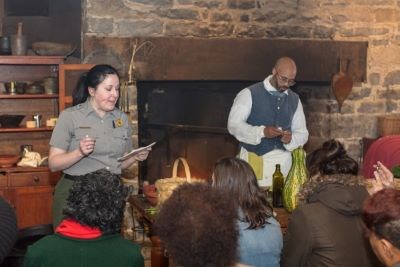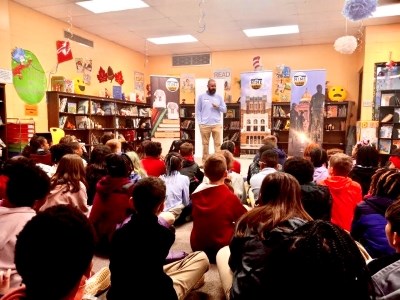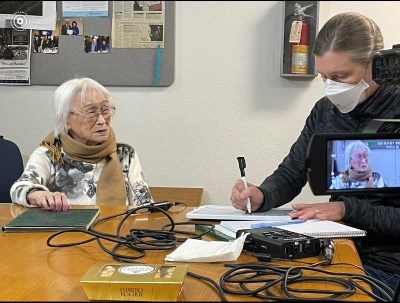Last updated: July 8, 2024
Article
2022 Freeman Tilden Award Recipients
The Freeman Tilden Awards are the highest interpretation awards presented to a National Park Service individual or team to recognize outstanding contributions to the profession of interpretation. The award was created to inspire and reward creative thinking and original programs and projects in our national parks that result in positive and meaningful impacts for the visitors and the preservation of parks.
National Recipients
Honoring the Historic Footprint: Cheyenne and Arapaho Warriors at Fort Marion
Steven J. Roberts
Region 1, 2, 4 (Southeast) | Castillo de San Marcos National Monument
- Duration:
- 1 minute, 30 seconds
Steven J. Roberts accepts the 2022 National Freeman Tilden Award for excellence in interpretation by an individual.

Honoring the Historic Footprint began as an important process to learn from, honor, and share the stories and truth of the Fort Marion Native American imprisonments. Collaboration to learn the perspective of the imprisoned, rather than the traditional U.S. army perspective, was rooted in the development of deep partnership with the Cheyenne and Arapaho Tribes. In November 2022, educational sessions and memorial ceremonies included approximately 30 Tribe members to travel to Fort Marion from their homes in Oklahoma, as well as hundreds of park visitors, to listen and learn from Tribe members about the history of the imprisonment and the intergenerational trauma it caused. It provided a chance to reflect on this history and its relevance today. Just as important, these events provided room for healing and to honor those warriors who had been imprisoned.
Universal Threads
Johanna Lombard, Ian Ferris, Jen Kolm, and Mat Stevens
Region 8, 9, 10, 12 (Pacific West) | Joshua Tree National Park
- Duration:
- 1 minute, 29 seconds
Johanna Lombard, Ian Ferris, Jen Kolm, and Mat Stevens accept the 2022 National Freeman Tilden Group Award for Excellence in Interpretation at Joshua Tree National Park.

New exhibits created in-house at Joshua Tree National Park fulfill the National Park Service commitment to engage Native American communities in meaningful ways. From start to finish, the park's traditionally associated Tribes collaborated with exhibit staff to share their stories and perspectives.
Visitors choose a colored line to follow as it weaves with others through a 1,500-square-foot exhibit hall inside Joshua Tree National Park Visitor Center in Twentynine Palms, California. These lines show the intertwining relationships between plants, animals, earth, sky, and human life. Oral histories, compelling stories, videos with captions and audio description, Indigenous art, collections materials, tactile elements, and audience-centered activities enhance the experience.
Partners: Agua Caliente Band of Cahuilla Indians, Augustine Band of Cahuilla Indians, Cabazon Band of Cahuilla Mission Indians, Cahuilla Band of Mission Indians, Chemehuevi Indian Tribe, City of Twentynine Palms, Colorado River Indian Tribes, Fort Mojave Indian Tribe, Los Coyotes Band of Mission Indians, Morongo Band of Mission Indians, Ramona Band of Cahuilla Indians, Santa Rosa Band of Cahuilla Indians, Soboba Band of Luiseño Indians, Torres Martinez Desert Cahuilla Indians, Twenty-Nine Palms Band of Mission Indians, and Yuhaaviatam of San Manuel Nation (formerly San Manuel Band of Mission Indians).
Regional Recipients
Franklin Delano Roosevelt Memorial Accessible Waysides and Exhibits
Glenn Klaus
Region 1 (National Capital) | National Mall and Memorial Parks

New exhibits at Franklin Delano Roosevelt Memorial allow visitors with sight impairments to experience the intricacies and intent of the memorial more fully. Memorials often include engravings, large sculptures, and broad scopes that may limit access to visitors with impairments.
Glenn Klaus spearheaded this project to add tactile models, audio description, and braille to increase access for all visitors. The exhibits are the result of an iterative design process with extensive review and testing by individuals and groups of people with disabilities. Read more about accessibility at FDR Memorial.
First, Look Inward: Preparation for Release of the NPS Study, Segregation in Virginia’s Parks 1916-1965
Ajena Rogers, Melissa Cobern, Claire Comer, George Liffert, Beth Parnicza, Dwayne Scheid, Rebecca Toy, Alexa Viets
Region 1 (Northeast) | 11 NPS units: Maggie L. Walker National Historic Site, George Washington Birthplace National Monument, Thomas Stone National Historic Site, Shenandoah National Park, Prince William Forest Park, Appomattox Court House National Historical Park, Colonial National Historical Park, Fredericksburg & Spotsylvania National Military Park, and Blue Ridge Parkway.

Teams from 11 National Park Service units along the east coast organized workshops to introduce park to the NPS study, Segregation in Virginia’s National Parks, 1916-1965. Tailored for each site, the workshops provided the opportunity for staff from multiple disciplines to understand and discuss the report’s findings and reflect and wrestle with its implications and impacts. The workshops addressed the necessary first step of looking inward prepare for consideration of actions for social justice, interpretation, community engagement, and relationships. Learn more about the NPS study, Segregation in Virginia’s National Parks, 1916-1965.
Inalienable Rights and Interpreting Hard History
Shannon Moeck
Region 1 (Northeast) | Cedar Creek & Belle Grove National Historical Park

Inalienable Rights is an annual, historical interpretation event that uses storytelling and living history to help visitors learn about the daily lives of the enslaved people. The event is a collaboration between the National Park Service, Belle Grove Plantation, the Slave Dwelling Project, and other historical organizations. Efforts to interpret enslavement, emancipation, and freedom in the Shenandoah Valley culminate each November when these partners come together to share the legacy of slavery with visitors. In 2022, Inalienable Rights expanded beyond Belle Grove to include programming at nearby local historical sites. Learn more about the Inalienable Rights event at bellegrove.org.
The History of Snee Farm Plantation
Paula Ogden-Muse, Tracy Stakely, Nathan Betcher, Dawn Davis, Kate Funk, Michelle Haas, Tom Sobol, Matthew Wood, Krista Pollett, Henry Evans, Bill Reilly, Cary Huffman, Ryan Delgado, Meghan Weber, Brett Spaulding
Region 1, 2, 4 (Southeast) | Charles Pinckney National Historic Site

New interactive museum exhibits at Snee Farm tell a more complete history of Charles Pickney and the stories of Snee Farm inhabitants, including enslaved workers. The previous exhibits, installed more than 25 years ago, portrayed a glorified perspective of Charles Pinckney’s association with the Constitution without evaluating problematic influences he and other delegates wielded regarding slavery.
Isle Royale Stay Wild
Katie Keller, Chris Amidon, Bridget Byrne, Jenna Behnke
Region 3, 4, 5 (Midwest) | Isle Royale National Park

Help Isle Royale Stay Wild. This message culminates a visitor orientation campaign that will reach a new generation of more diverse visitors. In 2020, building on a previously successful Leave No Trace program, Isle Royale began reimagining its visitor orientation messaging. Over three years, the interpretation team evaluated park audience, workshopped new language, and developed new interpretive products. Today, Isle Royale Stay Wild messaging weaves through videos, website, social media, The Greenstone newspaper, and all visitor orientation programs. Isle Royale Stay Wild connects a new generation of visitors to the ideals of wilderness preservation. View the Stay Wild Daytripper and Lodge Guest Orientation video.
Nonviolence, Integrity, Nice (Kindness), and Education
Brian Schwieger
Region 3, 4, 5 (Midwest) | Little Rock Central High School National Historic Site

This pilot program promotes the core values of the National Park Service, highlights the mission of Central High School National Historic Site and interprets four ideals intricately connected with the story of the Little Rock Nine: nonviolence, integrity, nice (kindness), and education. NINE has reached more than 1,000 fourth grade students and educators through in-person and virtual programming across Little Rock and Pulaski County elementary schools. The majority of these schools are Title I institutions with limited in field trip opportunities
Headwaters Podcast: Whitebark Pine
Daniel Lombardi, Michael Faist, Peri Sasnett, Andrew Smith
Region 6, 7, 8 (Intermountain) | Glacier National Park

Season two of the Headwaters podcast, is a five-part series on whitebark pine conservation that combines thoughtful, thematic content with well-crafted exploration of this valuable resource using multiple perspectives and exemplary media techniques. The series explores why whitebark pines matter, why they're dying, and the generational efforts to save them.
The series also addresses the purpose of national parks and our relationships with the places we love. It asks its listeners: can we have a positive impact on nature? The Headwaters podcast started in 2020 as an interpretive tool to reach visitors before, during, and after their visit, but has expanded to explore how Glacier National Park is connected to everything. The podcast is the result of collaboration between a large and diverse team of park employees and partners.
Connecting Families and Visitors to and through Archives, Artifacts, and Stories
Sarah Bone
Region 8, 9, 10, 12 (Pacific West) | Manzanar National Historic Site

Manzanar ranger Sarah Bone goes to extraordinary lengths to connect families with their archives, artifacts, and stories. She fosters healing for those Japanese Americans unconstitutionally incarcerated by their own government during World War II and promotes intergenerational understanding for their families. Sarah researches, conducts, and records oral history interviews; embarks on extensive archival research; and produces interpretive videos highlighting artifacts in Manzanar museum collections. Sarah links tangible artifacts to their intangible meanings and ties it all together through universal concepts. She integrates all of this in her programs to bring the past to life. Read about one woman's research of her grandparents and their siblings at manzanarcommittee.org.
Journeys at Katmai: An Activity Book for Not-So-Junior Rangers
Amber Kraft, Sarah Gage, Lian Law
Region 11 (Alaska) | Katmai National Park & Preserve

This self-paced learning experience allows adult visitors to be inspired by Katmai in a fun and engaging way. The Not-So-Junior Ranger program launched in 2022 and proved to as popular as the park's Junior Ranger program. The Journeys at Katmai: Not-So-Junior Ranger booklet is rooted in the park's primary interpretive themes and blends styles of engagement ranging from dialogic questions, essential themes, interpretive writing, and situational awareness. The inspiration from this project came from visitor comments asking about senior ranger programs, as well as the park’s recognition that Brooks Camp’s 40,000 annual visitors that come to see bears might not otherwise intentionally seek out opportunities to learn about the Katmai’s geologic and human history.
Tags
- appomattox court house national historical park
- blue ridge parkway
- castillo de san marcos national monument
- cedar creek & belle grove national historical park
- charles pinckney national historic site
- colonial national historical park
- fredericksburg & spotsylvania national military park
- george washington birthplace national monument
- glacier national park
- isle royale national park
- joshua tree national park
- katmai national park & preserve
- little rock central high school national historic site
- maggie l walker national historic site
- manzanar national historic site
- national mall and memorial parks
- prince william forest park
- shenandoah national park
- thomas stone national historic site
- tilden award
- interpretation award
